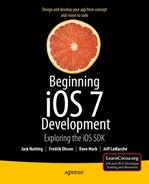In Chapter 3, we discussed MVC and built an application using it. You learned about outlets and actions, and you used them to tie a button control to a text label. In this chapter, we’re going to build an application that will take your knowledge of controls to a whole new level.
We’ll implement an image view, a slider, two different text fields, a segmented control, a couple of switches, and an iOS button that looks more like, well, an iOS button. You’ll see how to set and retrieve the values of various controls. You’ll learn how to use action sheets to force the user to make a choice, and how to use alerts to give the user important feedback. You’ll also learn about control states and the use of stretchable images to make buttons look the way they should.
Because this chapter’s application uses so many different user interface items, we’re going to work a little differently than we did in the previous two chapters. We’ll break our application into pieces, implementing one piece at a time. Bouncing back and forth between Xcode and the iOS simulator, we’ll test each piece before we move on to the next. Dividing the process of building a complex interface into smaller chunks makes it much less intimidating, as well as more like the actual process you’ll go through when building your own applications. This code-compile-debug cycle makes up a large part of a software developer’s typical day.
A Screen Full of Controls
As we mentioned, the application we’re going to build in this chapter is a bit more complex than the one we created in Chapter 3. We’ll still use only a single view and controller; but as you can see in Figure 4-1, there’s a lot more going on in this one view.
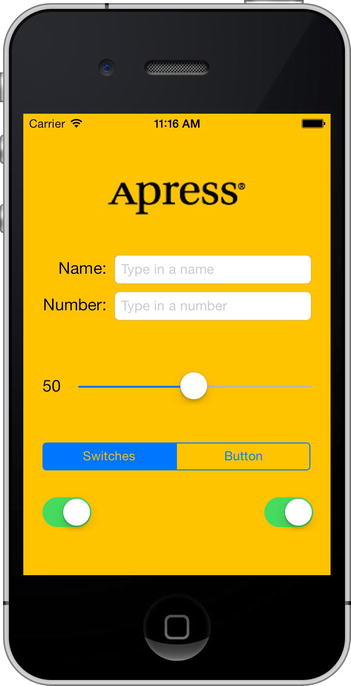
Figure 4-1. The Control Fun application features text fields, labels, a slider, and several other stock iPhone controls
The logo at the top of the iPhone screen is an image view; and in this application, it does nothing more than display a static image. Below the logo are two text fields: one that allows the entry of alphanumeric text and one that allows only numbers. Below the text fields is a slider. As the user moves the slider, the value of the label next to it will change so that it always reflects the slider’s current value.
Below the slider are a segmented control and two switches. The segmented control will toggle between two different types of controls in the space below it. When the application first launches, two switches will appear below the segmented control. Changing the value of either switch will cause the other one to change its value to match. Now, this isn’t something you would likely do in a real application, but it does demonstrate how to change the value of a control programmatically and how Cocoa Touch animates certain actions without you needing to do any work.
Figure 4-2 shows what happens when the user taps the segmented control. The switches disappear and are replaced by a button. When the Do Something button is pressed, an action sheet pops up, asking if the user really meant to tap the button (see Figure 4-3). This is the standard way of responding to input that is potentially dangerous or that could have significant repercussions, and it gives the user a chance to stop potential badness from happening. If Yes, I’m Sure! is selected, the application will put up an alert, letting the user know that everything is OK (see Figure 4-4).

Figure 4-2. Tapping the segmented controller on the left side causes a pair of switches to be displayed. Tapping the right side causes a button to be displayed
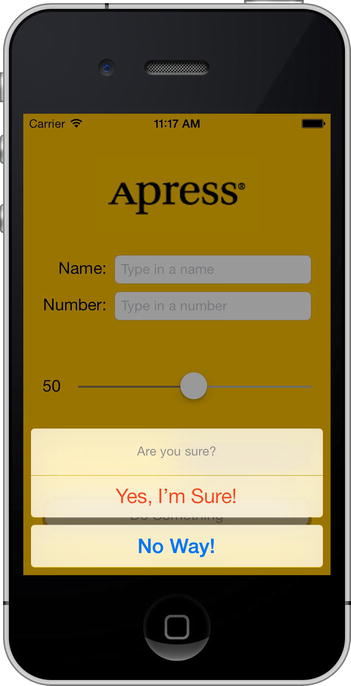
Figure 4-3. Our application uses an action sheet to solicit a response from the user
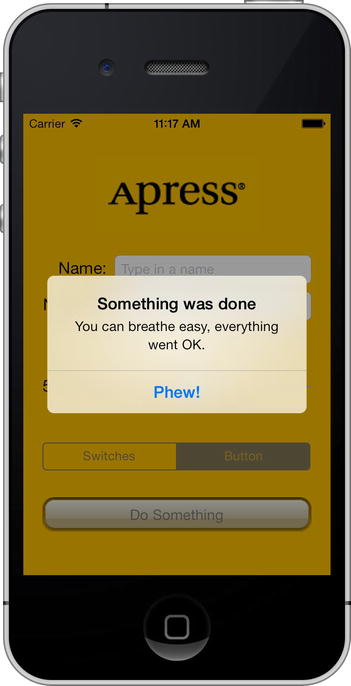
Figure 4-4. Alerts are used to notify the user when important things happen. We use one here to confirm that everything went OK
Active, Static, and Passive Controls
Interface controls are used in three basic modes: active, static (or inactive), and passive. The buttons that we used in the previous chapter are classic examples of active controls. You push them, and something happens—usually, a piece of code that you wrote fires.
Although many of the controls that you will use will directly trigger action methods, not all controls will. The image view that we’ll be implementing in this chapter is a good example of a control being used statically. A UIImageView can be configured to trigger action methods, but in our application the image view is passive—the user cannot do anything with it. Labels and image controls are often used in this manner.
Some controls can work in a passive mode, simply holding on to a value that the user has entered until you’re ready for it. These controls don’t trigger action methods, but the user can interact with them and change their values. A classic example of a passive control is a text field on a web page. Although it’s possible to create validation code that fires when the user tabs out of a field, the vast majority of web page text fields are simply containers for data that’s submitted to the server when the user clicks the submit button. The text fields themselves usually don’t cause any code to fire, but when the submit button is clicked, the text field’s data goes along for the ride.
On an iOS device, most of the available controls can be used in all three modes, and nearly all of them can function in more than one mode, depending on your needs. All iOS controls are subclasses of UIControl, so they are capable of triggering action methods. Many controls can be used passively, and all of them can be made inactive or invisible. For example, using one control might trigger another inactive control to become active. However, some controls, such as buttons, really don’t serve much purpose unless they are used in an active manner to trigger code.
There are some behavioral differences between controls on iOS and those on your Mac. Here are a few examples:
- Because of the multitouch interface, all iOS controls can trigger multiple actions, depending on how they are touched. The user might trigger a different action with a finger swipe across the control than with just a tap.
- You could have one action fire when the user presses down on a button and a separate action fire when the finger is lifted off the button.
- You could have a single control call multiple action methods on a single event. For example, you could have two different action methods fire on the Touch UpInside event when the user’s finger is lifted after touching that button.
Note Although controls can trigger multiple methods on iOS, the vast majority of the time, you’re probably better off implementing a single action method that does what you need for a particular use of a control. You won’t usually need this capability, but it’s good to keep it in mind when working in Interface Builder. Connecting an event to an action in Interface Builder does not disconnect a previously connected action from the same control! This can lead to surprising misbehaviors in your app, where a control will trigger multiple action methods. Keep an eye open when retargeting an event in Interface Builder, and make sure you remove old actions before connecting to new ones.
Another major difference between iOS and the Mac stems from the fact that, normally, iOS devices do not have a physical keyboard. The standard iOS software keyboard is actually just a view filled with a series of button controls that are managed for you by the system. Your code will likely never directly interact with the iOS keyboard.
Creating the Application
Let’s get started. Fire up Xcode if it’s not already open, and create a new project called Control Fun. We’re going to use the Single View Application template again, so create your project just as you did in the previous two chapters.
Now that you’ve created your project, let’s get the image we’ll use in our image view. The image must be imported into Xcode before it will be available for use inside Interface Builder, so we’ll import it now. You can use the image named apress_logo.png in the project archives in the 04 - Control Fun folder in the project archives. You’ll find two images in the folder, named apress_logo_344.png and apress_logo_172.png; these are the retina and non-retina versions of the same image. We’re going to add both of these to the new project’s image resource catalog and let the app decide which of them to use at runtime. If you’d rather use an image-pair of your own choosing, make sure that they are .png images sized correctly for the space available. The larger version should be less than 200 pixels tall and a maximum of 600 pixels wide, so that it can fit comfortably at the top of the view without being resized. The smaller one should be half the size in both dimensions.
In Xcode, select the Images.xcassets item and click the plus button in the lower-left corner of the editing area. This brings up a small menu of choices, from which you should select New Image Set. This creates a new spot for adding your actual image files. Right now it’s just called Image, but we want to give it a unique name, so we can refer to it elsewhere in the project. Select the Image item, bring up the attributes inspector (![]()
![]() 3, or Opt-Cmd-3), and use it to change the image’s name to apress_logo.
3, or Opt-Cmd-3), and use it to change the image’s name to apress_logo.
Now add the images themselves to the apress_logo image item by dragging each image from the Finder to the image detail box. Drag the smaller image to the spot labeled 1x and the larger to the spot labeled 2x.
Implementing the Image View and Text Fields
With the image added to your project, your next step is to implement the five interface elements at the top of the application’s screen: the image view, the two text fields, and the two labels (see Figure 4-5).
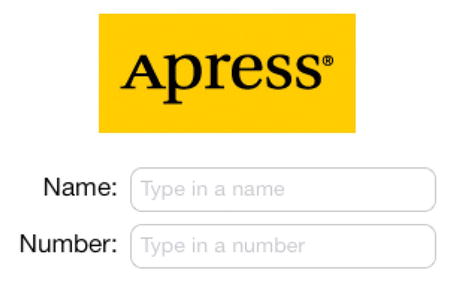
Figure 4-5. The image view, labels, and text fields we will implement first
Adding the Image View
In the project navigator, click Main.storyboard to open the file in Interface Builder. You’ll see the familiar white background and a single iPhone-sized view where you can lay out your application’s interface.
If the object library is not open, select View ![]() Utilities
Utilities ![]() Show Object Library to open it. Scroll about one-fourth of the way through the list until you find Image View (see Figure 4-6) or just type “image view” in the search field. Remember that the object library is the third icon on top of the library pane. You won’t find Image View under any of the other icons.
Show Object Library to open it. Scroll about one-fourth of the way through the list until you find Image View (see Figure 4-6) or just type “image view” in the search field. Remember that the object library is the third icon on top of the library pane. You won’t find Image View under any of the other icons.
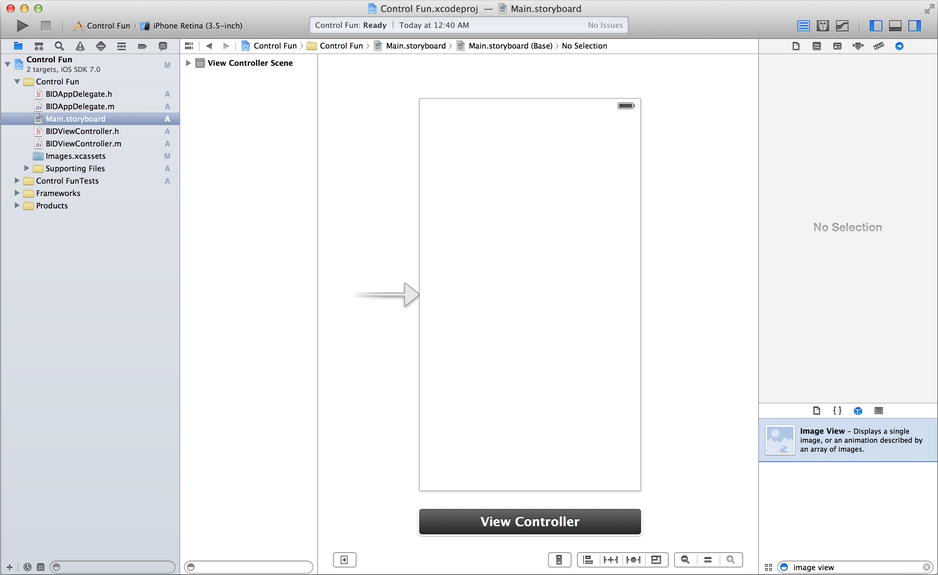
Figure 4-6. The Image View element in Interface Builder’s library
Drag an image view onto the view in the nib editor. Notice that, as you drag your image view out of the library, it changes size twice. As the drag makes its way out of the library pane, it takes the shape of a horizontal rectangle. Then, when your drag enters the frame of the view, the image view resizes to be the size of the view, minus the status bar at the top. This behavior is normal. Indeed, in many cases it is exactly what you want because the first image you place in a view is often a background image. Release the drag inside the view, taking care that the new UIImageView snaps to the sides and bottom of the surrounding view. In this particular case, we actually don’t want our image view to take the entire space, so we use the drag handles to resize the image view to the approximate size of the image previously imported into Xcode. Don’t worry about getting it exactly right yet; we’ll take care of that in the next section. Figure 4-7 shows our resized UIImageView.

Figure 4-7. Our resized UIImageView, sized to accommodate the image we will place here
Remember that, if you ever encounter difficulty selecting an item in the editing area, you can bring up the editor’s list view by clicking the small triangle icon in the lower-left corner. Now, click the item you want selected in the list and, sure enough, that item will be selected in the editor.
To get at an object that is nested inside another object, click the disclosure triangle to the left of the enclosing object to reveal the nested object. In this case, to select the image view, first click the disclosure triangle to the left of the view. Then, when the image view appears in the dock, click it, and the corresponding image view in the nib editor will be selected.
With the image view selected, bring up the object attributes inspector by pressing ![]()
![]() 4, and you should see the editable options of the UIImageView class (see Figure 4-8).
4, and you should see the editable options of the UIImageView class (see Figure 4-8).
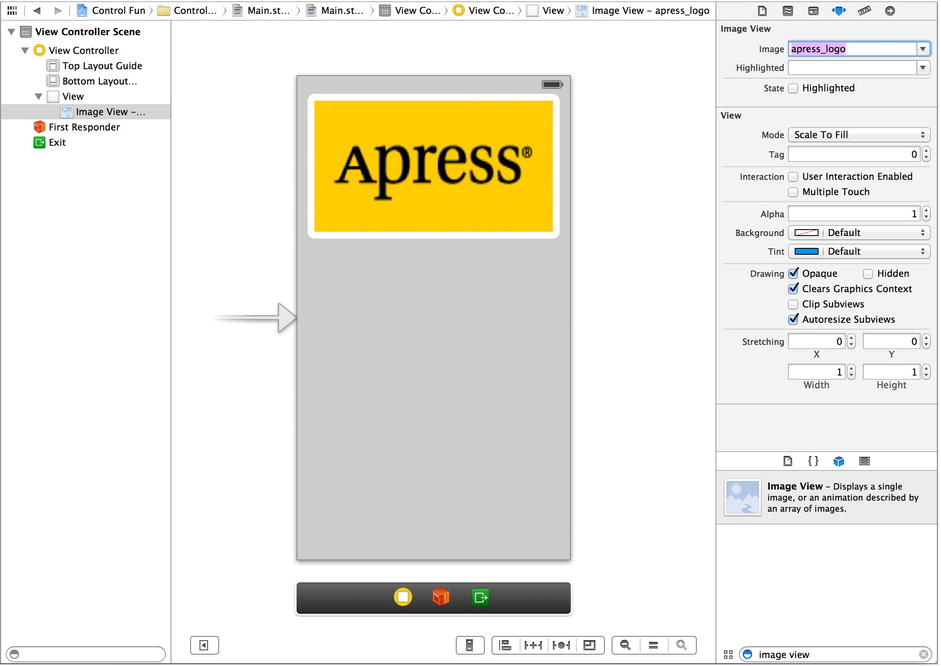
Figure 4-8. The image view attributes inspector. We selected our image from the Image pop-up at the top of the inspector, and this populated the image view with our image
The most important setting for our image view is the topmost item in the inspector, labeled Image. Click the little arrow to the right of the field to see a pop-up menu that lists the available images. This list should include any images you added to your project’s image assets catalog. Select the image you added earlier. Your image should now appear in your image view.
Resizing the Image View
As it turns out, the image we used is a fair amount smaller than the image view in which it was placed. If you take another look at Figure 4-8, you’ll notice that the image we used was scaled to completely fill the image view. A big clue that this is so is the Mode setting in the attributes inspector, which is set to Scale To Fill.
Though we could keep our app this way, it’s generally a good idea to do any image scaling before runtime, as image scaling takes time and processor cycles. Let’s resize our image view to the exact size of our image.
Make sure the image view is selected and that you can see the resize handles. Now select the image view one more time. You should see the outline of the image view replaced by a thick, gray border. Finally, press ![]() = or select Editor
= or select Editor ![]() Size to Fit Content. This will resize the image view to match the size of its contents.
Size to Fit Content. This will resize the image view to match the size of its contents.
Now that the image view is resized, move it into its final position. You’ll need to click off it, and then click it again to reselect it. Now drag the image view so the top hits the blue guideline toward the top of your view and it is centered according to the blue guideline. Note that you can also center an item in its containing view by choosing Editor ![]() Align
Align ![]() Horizontal Center in Container, which also does an extra trick: it establishes a constraint that makes the image view always want to remain centered within the view that contains it, even if that view changes size. You may have noticed the way Interface Builder shows some solid lines running from an edge of one view to an edge of its superview, in contrast to the dashed blue lines that are shown while you’re dragging things around. These solid lines represent constraints, which give you a way of expressing layout rules directly in Interface Builder. The new constraint you just created is also represented by a solid orange line, this one running the entire height of the main view (see Figure 4-9). This specifies that the center of the image view will remain horizontally centered within its parent view, even if the parent view’s geometry changes (as it may, for example, when the device is rotated). We’ll talk more about constraints throughout the book.
Horizontal Center in Container, which also does an extra trick: it establishes a constraint that makes the image view always want to remain centered within the view that contains it, even if that view changes size. You may have noticed the way Interface Builder shows some solid lines running from an edge of one view to an edge of its superview, in contrast to the dashed blue lines that are shown while you’re dragging things around. These solid lines represent constraints, which give you a way of expressing layout rules directly in Interface Builder. The new constraint you just created is also represented by a solid orange line, this one running the entire height of the main view (see Figure 4-9). This specifies that the center of the image view will remain horizontally centered within its parent view, even if the parent view’s geometry changes (as it may, for example, when the device is rotated). We’ll talk more about constraints throughout the book.

Figure 4-9. Once we have resized our image view to fit the size of its image, we drag it into position using the view’s blue guidelines, and create a constraint to keep it centered
Tip Dragging and resizing views in Interface Builder can be tricky. Don’t forget about the hierarchical list mode, activated by clicking the small triangle icon at the bottom of the nib editor’s dock. When it comes to resizing, hold down the ![]() key, and Interface Builder will draw some helpful red lines on the screen that make it much easier to get a sense of the image view’s size. This trick won’t work with dragging since the
key, and Interface Builder will draw some helpful red lines on the screen that make it much easier to get a sense of the image view’s size. This trick won’t work with dragging since the ![]() key will prompt Interface Builder to make a copy of the dragged object. However, if you select Editor
key will prompt Interface Builder to make a copy of the dragged object. However, if you select Editor ![]() Canvas
Canvas ![]() Show Bounds Rectangles, Interface Builder will draw a line around all of your interface items, making them easier to see. You can turn off those lines by selecting Show Bounds Rectangles a second time.
Show Bounds Rectangles, Interface Builder will draw a line around all of your interface items, making them easier to see. You can turn off those lines by selecting Show Bounds Rectangles a second time.
Setting View Attributes
Select your image view, and then switch your attention back over to the attributes inspector. Below the Image View section of the inspector is the View section. As you may have deduced, the pattern here is that the attributes that are specific to the selected object are shown at the top, followed by more general attributes that apply to the selected object’s parent class. In this case, the parent class of UIImageView is UIView, so the next section is simply labeled View, and it contains attributes that any view class will have.
The Mode Attribute
The first option in the view inspector is a pop-up menu labeled Mode. The Mode menu defines how the view will display its content. This determines how the image will be aligned inside the view and whether it will be scaled to fit. Feel free to play with the various options, but the default value of Scale To Fill will work fine for now.
Keep in mind that choosing any option that causes the image to scale will potentially add processing overhead, so it’s best to avoid those and size your images correctly before you import them. If you want to display the same image at multiple sizes, generally it’s better to have multiple copies of the image at different sizes in your project, rather than force the iOS device to do scaling at runtime. Of course, there are times when scaling at runtime is appropriate; this is a guideline, not a rule.
Tag
The next item, Tag, is worth mentioning, though we won’t be using it in this chapter. All subclasses of UIView, including all views and controls, have a property called tag, which is just a numeric value that you can set here or in code. The tag is designed for your use; the system will never set or change its value. If you assign a tag value to a control or view, you can be sure that the tag will always have that value unless you change it.
Tags provide an easy, language-independent way of identifying objects on your interface. Let’s say you have five different buttons, each with a different label, and you want to use a single action method to handle all five buttons. In that case, you probably need some way to differentiate among the buttons when your action method is called. Sure, you could look at the button’s title, but code that does that probably won’t work when your application is translated into Swahili or Sanskrit. Unlike labels, tags will never change, so if you set a tag value here in Interface Builder, you can then use that as a fast and reliable way to check which control was passed into an action method in the sender argument.
Interaction Checkboxes
The two checkboxes in the Interaction section have to do with user interaction. The first checkbox, User Interaction Enabled, specifies whether the user can do anything at all with this object. For most controls, this box will be checked because, if it’s not, the control will never be able to trigger action methods. However, image views default to unchecked because they are often used just for the display of static information. Since all we’re doing here is displaying a picture on the screen, there is no need to turn this on.
The second checkbox is Multiple Touch, and it determines whether this control is capable of receiving multitouch events. Multitouch events allow complex gestures like the pinch gesture used to zoom in in many iOS applications. We’ll talk more about gestures and multitouch events in Chapter 13. Since this image view doesn’t accept user interaction at all, there’s no reason to turn on multitouch events; leave the checkbox unchecked.
The Alpha Value
The next item in the inspector is Alpha. Be careful with this one. Alpha defines how transparent your image is—how much of what’s beneath it shows through. It’s defined as a floating-point number between 0.0 and 1.0, where 0.0 is fully transparent and 1.0 is completely opaque. If you use any value less than 1.0, your iOS device will draw this view with some amount of transparency, so that any objects behind it show through. With a value of less than 1.0, even if there’s nothing interesting behind your image, you will cause your application to spend processor cycles compositing your partially-transparent view over the emptiness behind it. Therefore, don’t set Alpha to anything other than 1.0 unless you have a very good reason for doing so.
Background
The next item down, Background, is a property inherited from UIView, and it determines the color of the background for the view. For image views, this matters only when an image doesn’t fill its view and is letterboxed, or when parts of the image are transparent. Since we’ve sized our view to perfectly match our image, this setting will have no visible effect, so we can leave it alone.
Tint
The next control lets you specify a tint color for the selected view. This is a color that can be used to show a highlight or selected state in a GUI component. UIImageView doesn’t use the tint color, so just ignore this for now. Later on we will encounter other GUI components that actually do use the tint color.
Drawing Checkboxes
Below Tint is a series of Drawing checkboxes. The first one is labeled Opaque. That should be checked by default; if not, click to check that checkbox. This tells iOS that nothing behind your view needs to be drawn and allows iOS’s drawing methods to do some optimizations that speed up drawing.
You might be wondering why we need to select the Opaque checkbox when we’ve already set the value of Alpha to 1.0 to indicate no transparency. The alpha value applies to the parts of the image to be drawn; but if an image doesn’t completely fill the image view, or there are holes in the image thanks to an alpha channel, the objects below will still show through, regardless of the value set in Alpha. By selecting Opaque, we are telling iOS that nothing behind this view ever needs to be drawn, no matter what, so it does not need to waste processing time with anything behind our object. We can safely select the Opaque checkbox because we selected Size To Fit earlier, which caused the image view to match the size of the image it contains.
The Hidden checkbox does exactly what you think it does. If it’s checked, the user can’t see this object. Hiding an object can be useful at times, as you’ll see later in this chapter when we hide our switches and button; however, the vast majority of the time—including now—you want this to remain unchecked.
The next checkbox, Clears Graphics Context, will rarely need to be checked. When it is checked, iOS will draw the entire area covered by the object in transparent black before it actually draws the object. Again, it should be turned off for the sake of performance and because it’s rarely needed. Make sure this checkbox is unchecked (it is likely checked by default).
Clip Subviews is an interesting option. If your view contains subviews, and those subviews are not completely contained within the bounds of its parent view, this checkbox determines how the subviews will be drawn. If Clip Subviews is checked, only the portions of subviews that lie within the bounds of the parent will be drawn. If Clip Subviews is unchecked, subviews will be drawn completely, even if they lie outside the bounds of the parent.
Clip Subviews is unchecked by default. It might seem that the default behavior should be the opposite of what it actually is, so that child views won’t be able to draw all over the place. However, calculating the clipping area and displaying only part of the subviews is a somewhat costly operation, mathematically speaking; most of the time, a subview won’t lie outside the bounds of its superview. You can turn on Clip Subviews if you really need it for some reason, but it is off by default for the sake of performance.
The last checkbox in this section, Autoresize Subviews, tells iOS to resize any subviews if this view is resized. Leave this checked (since we don’t allow our view to be resized, it really does not matter whether it’s checked).
Stretching
Next up is a section simply labeled Stretching. You can leave your yoga mat in the closet, though, because the only stretching going on here is in the form of rectangular views being redrawn as they’re resized on the screen. The idea is that, rather than the entire content of a view being stretched uniformly, you can keep the outer edges of a view, such as the beveled edge of a button, looking the same even as the center portion stretches.
The four floating-point values set here let you declare which portion of the rectangle is stretchable by specifying a point at the upper-left corner of the view and the size of the stretchable area, all in the form of a number between 0.0 and 1.0 that represents a portion of the overall view size. For example, if you wanted to keep 10% of each edge not stretchable, you would specify 0.1 for both X and Y, and 0.8 for both Width and Height. In this case, we’re going to leave the default values of 0.0 for X and Y, and 1.0 for Width and Height. Most of the time, you will not change these values.
Adding the Text Fields
With your image view finished, it’s time to bring on the text fields. Grab a text field from the library, and drag it into the View, underneath the image view. Use the blue guidelines to align it with the right margin and make it snug, just under your image view (see Figure 4-10).
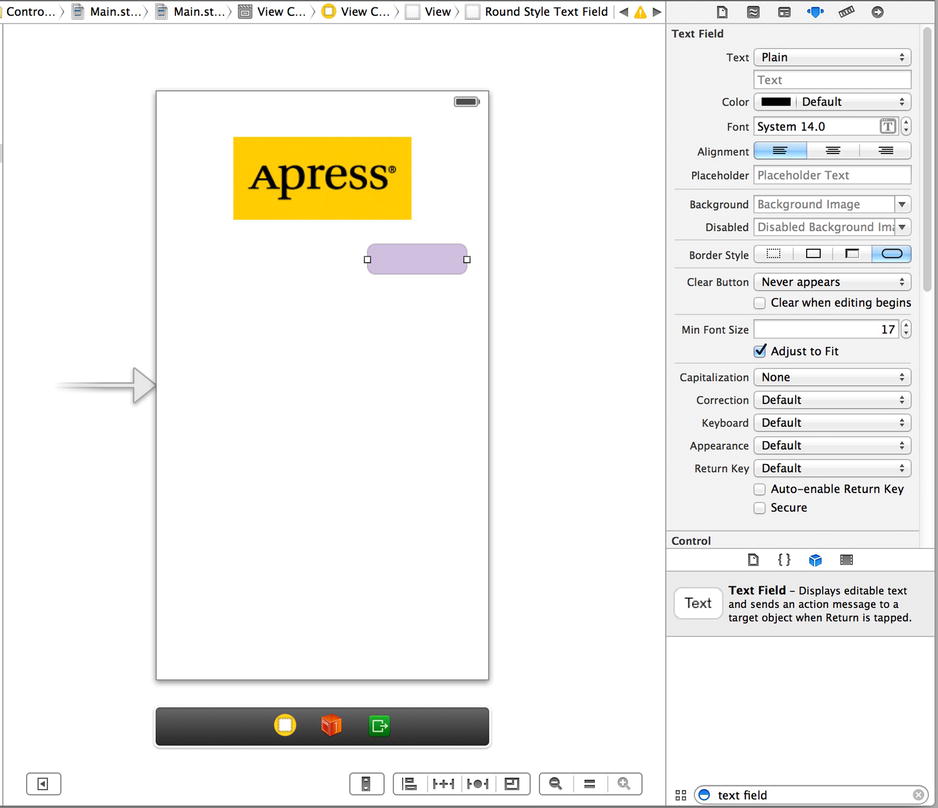
Figure 4-10. We dragged a text field out of the library and dropped it onto the view, just below our image view and touching the right-hand side’s blue guideline
A horizontal blue guideline will appear just above the text field when you move it very close to the bottom of your image view. That guideline tells you when the object you are dragging is the minimum reasonable distance from an adjacent object. You can leave your text field there for now; but to give it a balanced appearance, consider moving the text field just a little farther down. Remember that you can always use Interface Builder to edit your GUI again in order to change the position and size of interface elements—without needing to change code or reestablish connections.
After you drop the text field, grab a label from the library, and then drag that over so it is aligned with the left margin of the view and vertically with the text field you placed earlier. Notice that multiple blue guidelines will pop up as you move the label around, making it easy to align the label to the text field using the top, bottom, or middle of the label. We’re going to align the label and the text field using the baseline, which shows up as you’re dragging around the middle of those guidelines (see Figure 4-11).

Figure 4-11. Aligning the label and text field using the baseline guide
Double-click the label you just dropped, change it to read Name: instead of Label (note the colon character at the end of the label), and press the Return key to commit your changes.
Next, drag another text field from the library to the view and use the guidelines to place it below the first text field (see Figure 4-12).
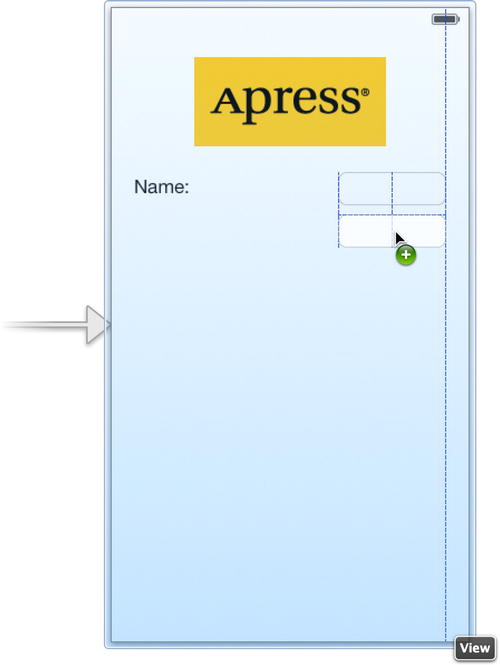
Figure 4-12. Adding the second text field
Once you’ve added the second text field, grab another label from the library and place it on the left side, below the existing label. Again, use the middle blue guideline to align your new label with the second text field. Double-click the new label and change it to read Number: (again, don’t forget the colon).
Now, let’s expand the size of the bottom text field to the left, so it is snug up against the right side of the label. Why start with the bottom text field? We want the two text fields to be the same size, and the bottom label is longer.
Single-click the bottom text field and drag the left resize dot to the left until a blue guideline appears to tell you that you are as close as you should ever be to the label (see Figure 4-13). This particular guideline is somewhat subtle—it’s only as tall as the text field itself, so keep your eyes peeled.

Figure 4-13. Expanding the size of the bottom text field
Now, expand the top text field in the same way, so that it matches the bottom one in size. Once again, a blue guideline provides some help, and this one extends all the way down to the other text field, making it easier to spot.
We’re basically finished with the text fields, except for one small detail. Look back at Figure 4-5. Do you see how the Name: and Number: are right-aligned? Right now, ours are both against the left margin. To align the right sides of the two labels, click the Name: label, hold down the ![]() (Shift) key, and click the Number: label, so both labels are selected. Next, press
(Shift) key, and click the Number: label, so both labels are selected. Next, press ![]()
![]() 4 to bring up the attributes inspector and make sure the Label section is expanded, so you can see the label-specific attributes. Just click the Label section header to expand and compact it. Now use the Alignment control in the inspector to make the content of these labels right-justified, and then make a constraint to make sure these two fields are always the same width by selecting Editor
4 to bring up the attributes inspector and make sure the Label section is expanded, so you can see the label-specific attributes. Just click the Label section header to expand and compact it. Now use the Alignment control in the inspector to make the content of these labels right-justified, and then make a constraint to make sure these two fields are always the same width by selecting Editor ![]() Pin
Pin ![]() Widths Equally.
Widths Equally.
When you are finished, the interface should look very much like the one shown in Figure 4-5. The only difference is the light-gray text in each text field. We’ll add that now.
Select the top text field (the one next to the Name: label) and press ![]()
![]() 4 to bring up the attributes inspector (see Figure 4-14). The text field is one of the most complex iOS controls, as well as one of the most commonly used. Let’s take a walk through the settings, beginning from the top of the inspector.
4 to bring up the attributes inspector (see Figure 4-14). The text field is one of the most complex iOS controls, as well as one of the most commonly used. Let’s take a walk through the settings, beginning from the top of the inspector.
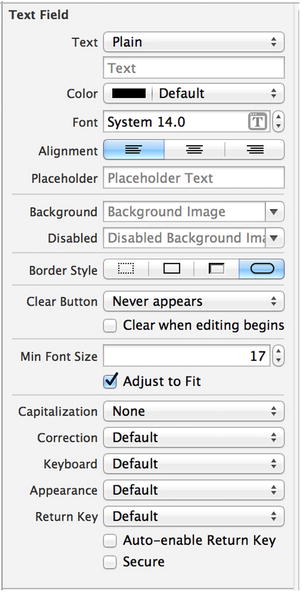
Figure 4-14. The inspector for a text field showing the default values
Text Field Inspector Settings
In the first section, the Text label points out two controls that give you some control over the text that will appear in the text field. The upper one is a pop-up button that lets you choose between plain text and attributed text, which can contain a variety of fonts and other attributes. Let’s leave that pop-up button set to Plain for now. Immediately below that, you can set a default value for the text field. Whatever you type here will show up in the text field when your application launches, instead of just a blank space.
After that comes a series of controls that let you set the font and font color. We’ll leave the Color at the default value of black. Note that the Color pop-up is divided into two parts. The right side allows you to select from a set of preselected colors, and the left side gives you access to a color well to more precisely specify your color.
The Font setting is divided into three parts. On the right side is a control that lets you increment or decrement the text size, one point at a time. The left side allows you to manually edit the font name and size. Finally, click the T-in-a-box icon to bring up a pop-up window that lets you set the various font attributes. We’ll leave the Font at its default setting of System 14.0.
Below these fields are three buttons for controlling the alignment of the text displayed in the field. We’ll leave this setting at the default value of left-aligned (the leftmost button).
Rounding out this first section, Placeholder allows you to specify a bit of text that will be displayed in gray inside the text field, but only when the field does not have a value. You can use a placeholder instead of a label if space is tight, or you can use it to clarify what the user should type into this text field. Type in the text Type in a name as the placeholder for our currently selected text field, and then hit Return to commit the change.
The next two fields, Background and Disabled, are used only if you need to customize the appearance of your text field, which is completely unnecessary and actually ill-advised the vast majority of the time. Users expect text fields to look a certain way. We’re going to skip over these fields, leaving them set to their defaults.
Next are four buttons labeled Border Style. These allow you to change the way the text field’s edge will be drawn. The default value (the rightmost button) creates the text field style that users are most accustomed to seeing for normal text fields in an iOS application. Feel free to try all four different styles. When you’re finished experimenting, set this setting back to the rightmost button.
Below the border setting is a Clear Button pop-up button, which lets you choose when the clear button should appear. The clear button is the small X that can appear at the right end of a text field. Clear buttons are typically used with search fields and other fields where you would be likely to change the value frequently. They are not typically included on text fields used to persist data, so leave this at the default value of Never appears.
The Clear when editing begins checkbox specifies what happens when the user touches this field. If this box is checked, any value that was previously in this field will be deleted, and the user will start with an empty field. If this box is unchecked, the previous value will remain in the field, and the user will be able to edit it. Leave this checkbox unchecked.
The next section starts with a control that lets you set the minimum font size that the text field will use for displaying its text. Leave that at its default value for now.
The Adjust to Fit checkbox specifies whether the size of the text should shrink if the text field is reduced in size. Adjusting to fit will keep the entire text visible in the view, even if the text would normally be too big to fit in the allotted space. This checkbox works in conjunction with the minimum font size setting. No matter the size of the field, the text will not be resized below that minimum size. Specifying a minimum size allows you to make sure that the text doesn’t get too small to be readable.
The next section defines how the keyboard will look and behave when this text field is being used. Since we’re expecting a name, let’s change the Capitalization pop-up to Words. This causes every word to be automatically capitalized, which is what you typically want with names.
The next three pop-ups—Correction, Keyboard, and Appearance—can be left at their default values. Take a minute to look at each to get a sense of what these settings do.
Next is the Return Key pop-up. The Return key is the key on the lower right of the keyboard, and its label changes based on what you’re doing. If you are entering text into Safari’s search field, for example, then it says Search. In an application like ours, where the text fields share the screen with other controls, Done is the right choice. Make that change here.
If the Auto-enable Return Key checkbox is checked, the Return key is disabled until at least one character is typed into the text field. Leave this unchecked because we want to allow the text field to remain empty if the user prefers not to enter anything.
The Secure checkbox specifies whether the characters being typed are displayed in the text field. You would check this checkbox if the text field was being used as a password field. Leave it unchecked for our app.
The next section allows you to set control attributes inherited from UIControl; however, these generally don’t apply to text fields and, with the exception of the Enabled checkbox, won’t affect the field’s appearance. We want to leave these text fields enabled, so that the user can interact with them. Leave the default settings in this section.
The last section on the inspector, View, should look familiar. It’s identical to the section of the same name on the image view inspector we looked at earlier. These are attributes inherited from the UIView class; since all controls are subclasses of UIView, they all share this section of attributes. As you did earlier for the image view, check the Opaque checkbox and uncheck Clears Graphics Context and Clip Subviews—for the reasons we discussed earlier.
Setting the Attributes for the Second Text Field
Next, single-click the lower text field (the one next to the Number: label) in the View window and return to the inspector. In the Placeholder field, type Type in a number, and make sure Clear When Editing Begins is unchecked. A little farther down, click the Keyboard pop-up menu. Since we want the user to enter only numbers, not letters, select Number Pad. This ensures that the users will be presented with a keyboard containing only numbers, meaning they won’t be able to enter alphabetical characters, symbols, or anything other than numbers. We don’t need to set the Return Key value for the numeric keypad because that style of keyboard doesn’t have a Return key; therefore, all of the other inspector settings can stay at the default values. As you did earlier, check the Opaque checkbox and uncheck Clears Graphics Context and Clip Subviews.
Creating and Connecting Outlets
We are almost ready to take our app for its first test drive. For this first part of the interface, all that’s left is creating and connecting our outlets. The image view and labels on our interface do not need outlets because we don’t need to change them at runtime. The two text fields, however, are passive controls that hold data we’ll need to use in our code, so we need outlets pointing to each of them.
As you probably remember from the previous chapter, Xcode allows us to create and connect outlets at the same time using the assistant editor. Go into the assistant editor now by selecting the middle toolbar button labeled Editor or by selecting View ![]() Assistant Editor
Assistant Editor ![]() Show Assistant Editor.
Show Assistant Editor.
Make sure your nib file is selected in the project navigator. If you don’t have a large amount of screen real estate, you might also want to select View ![]() Utilities
Utilities ![]() Hide Utilities to hide the utility pane during this step. When you bring up the assistant editor, the nib editing pane will be split in two, with Interface Builder in one half and either BIDViewController.h or BIDViewController.m in the other (see Figure 4-15). This new editing area—the one on the right—is the assistant.
Hide Utilities to hide the utility pane during this step. When you bring up the assistant editor, the nib editing pane will be split in two, with Interface Builder in one half and either BIDViewController.h or BIDViewController.m in the other (see Figure 4-15). This new editing area—the one on the right—is the assistant.

Figure 4-15. The nib editing area with the assistant turned on. You can see the assistant area on the right, showing the code from BIDViewController.m
You’ll see that the upper boundary of the assistant includes a jump bar, much like the normal editor pane. One important feature of the assistant’s jump bar is a set of “smart” selections, which let you switch between a variety of files that Xcode believes are relevant, based on what appears in the main view. By default, it shows a group of files labeled Automatic. These include any .h and .m files relevant to the current selection in the editor. In this case, that includes both source code files for the controller class. Take a few minutes to click around the jump bar at the top of the assistant, just to get a feel for what’s what. Once you have a sense of the jump bar and files represented there, move on.
Now comes the fun part. Make sure BIDViewController.m is showing in the assistant (use the jump bar to return there if necessary). Next, control-drag from the top text field in the view over to the BIDViewController.m source code, right below the @interface line. You should see a gray pop-up that reads Insert Outlet, Action, or Outlet Collection (see Figure 4-16). Release the mouse button, and you’ll get the same pop-up you saw in the previous chapter. We want to create an outlet called nameField, so type nameField into the Name field (say that five times fast!), and then hit Return or click the Connect button.

Figure 4-16. With the assistant turned on, we control-drag over to the source code in order to simultaneously create the nameField outlet and connect it to the appropriate text field
You now have a property called nameField in BIDViewController, and it has been connected to the top text field. Do the same for the second text field, creating and connecting it to a property called numberField.
Let’s see how our app works, shall we? Select Product ![]() Run. Your application should come up in the iOS simulator. Click the Name text field, and the traditional keyboard should appear. Type in a name, and then tap the Number field. The numeric keypad should appear (see Figure 4-17). Cocoa Touch gives us all this functionality for free just by adding text fields to our interface.
Run. Your application should come up in the iOS simulator. Click the Name text field, and the traditional keyboard should appear. Type in a name, and then tap the Number field. The numeric keypad should appear (see Figure 4-17). Cocoa Touch gives us all this functionality for free just by adding text fields to our interface.
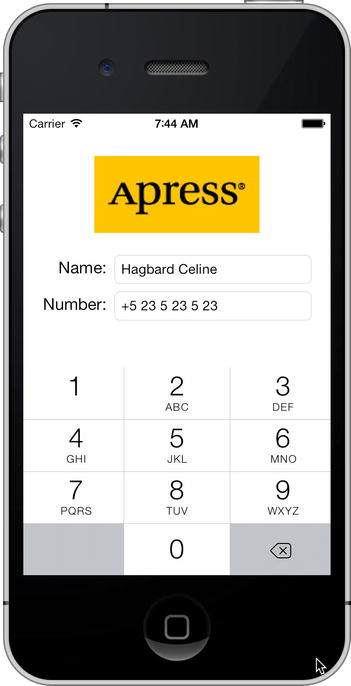
Figure 4-17. The keyboard comes up automatically when you touch either the text field or the number field
Woo-hoo! But there’s a little problem. How do you get the keyboard to go away? Go ahead and try. We’ll wait right here while you do.
Closing the Keyboard When Done Is Tapped
Because the keyboard is software-based rather than a physical keyboard, we need to take a few extra steps to make sure the keyboard goes away when the user is finished with it. When the user taps the Done button on the text keyboard, a Did End On Exit event will be generated; at that time, we need to tell the text field to give up control, so that the keyboard will go away. In order to do that, we need to add an action method to our controller class.
Select BIDViewController.h in the project navigator, and add the following line of code, shown in bold:
#import <UIKit/UIKit.h>
@interface BIDViewController : UIViewController
- (IBAction)textFieldDoneEditing:(id)sender;
@end
When you selected the header file in the project navigator, you probably noticed that the assistant we opened earlier has adapted to having a source code file selected in the main editor pane, and it now automatically shows the selected file’s counterpart. If you select a .h file, the assistant will automatically show the matching .m file, and vice versa. This is a remarkably handy Xcode capability! As a result of this behavior, BIDViewController.m is now shown in the assistant view, ready for us to implement this method.
Add this action method at the bottom of BIDViewController.m, just before the @end:
- (IBAction)textFieldDoneEditing:(id)sender {
[sender resignFirstResponder];
}
As you learned in Chapter 2, the first responder is the control with which the user is currently interacting. In our new method, we tell our control to resign as a first responder, giving up that role to the previous control the user worked with. When a text field yields first responder status, the keyboard associated with it goes away.
Save both of the files you just edited. Let’s hop back to the storyboard and trigger this action from both of our text fields.
Select Main.storyboard in the project navigator, single-click the Name text field, and press ![]()
![]() 6 to bring up the connections inspector. This time, we don’t want the Touch Up Inside event that we used in the previous chapter. Instead, we want Did End On Exit since that event will fire when the user taps the Done button on the text keyboard.
6 to bring up the connections inspector. This time, we don’t want the Touch Up Inside event that we used in the previous chapter. Instead, we want Did End On Exit since that event will fire when the user taps the Done button on the text keyboard.
Drag from the circle next to Did End On Exit to the yellow View Controller icon, shown just below the view you’ve been configuring, and let go. A small pop-up menu will appear containing the name of a single action, the one we just added. Click the textFieldDoneEditing: action to select it. You can also do this by dragging to the textFieldDoneEditing: method in the assistant view. Repeat this procedure with the other text field, save your changes, and then press ![]() R to run the app again.
R to run the app again.
When the simulator appears, click the Name field, type in something, and then tap the Done button. Sure enough, the keyboard drops away, just as you expected. All right! What about the Number field, though? Um, where’s the Done button on that one (see Figure 4-17)?
Well, crud! Not all keyboard layouts feature a Done button. We could force the user to tap the Name field and then tap Done, but that’s not very user-friendly, is it? And we most definitely want our application to be user-friendly. Let’s see how to handle this situation.
Touching the Background to Close the Keyboard
Can you recall what Apple’s iPhone applications do in this situation? Well, in most places where there are text fields, tapping anywhere in the view where there’s no active control will cause the keyboard to go away. How do we implement that?
The answer is probably going to surprise you because of its simplicity. Our view controller has a property called view that it inherited from UIViewController. This view property corresponds to the View in the storyboard. The view property points to an instance of UIView that acts as a container for all the items in our user interface. It has no appearance in the user interface, but it covers the entire iPhone window, sitting “below” all of the other user interface objects. It is sometimes referred to as a container view because its main purpose is to simply hold other views and controls. For all intents and purposes, the container view is the background of our user interface.
Using Interface Builder, we can change the class of the object that view points to so that its underlying class is UIControl instead of UIView. Because UIControl is a subclass of UIView, it is perfectly appropriate for us to connect our view property to an instance of UIControl. Remember that when a class subclasses another object, it is just a more specialized version of that class, so a UIControl is a UIView. If we simply change the instance that is created from UIView to UIControl, we gain the ability to trigger action methods. Before we do that, though, we need to create an action method that will be called when the background is tapped.
We need to add one more action to our controller class. Add the following method to your BIDViewController.m file, just before @end:
- (IBAction)backgroundTap:(id)sender {
[self.nameField resignFirstResponder];
[self.numberField resignFirstResponder];
}
This method simply tells both text fields to yield first responder status if they have it. It is perfectly safe to call resignFirstResponder on a control that is not the first responder, so we can call it on both text fields without needing to check whether either is the first responder. Note that, unlike the last time we added an action method, when we included the method in both the header and the implementation, this time we’re just putting it in the implementation. Xcode is smart enough these days to let us skip the redundant declaration in the header file just for purposes of connecting our GUI to our code. If we wanted to make this method available for other classes to use, we’d still need to include the method declaration in the header file, too.
Tip You’ll be switching between header and implementation files a lot as you code. Fortunately, in addition to the convenience provided by the assistant, Xcode also has a key combination that will switch between counterparts quickly. The default key combination is ![]()
![]()
![]() , although you can change it to anything you want using Xcode’s preferences.
, although you can change it to anything you want using Xcode’s preferences.
Save this file. Now, select the storyboard again. Make sure your document outline is expanded (click the triangle icon at the bottom left of the editing area to toggle this), and then single-click View so it is selected. Do not select one of your view’s subitems; we want the container view itself.
Next, press ![]()
![]() 3 to bring up the identity inspector(see Figure 4-18). This is where you can change the underlying class of any object instance in your nib file.
3 to bring up the identity inspector(see Figure 4-18). This is where you can change the underlying class of any object instance in your nib file.
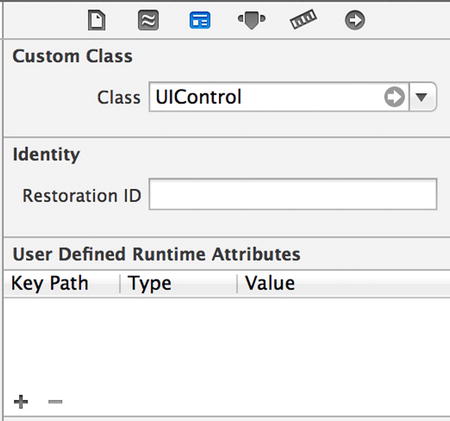
Figure 4-18. We switched Interface Builder to list view and selected our view. We then switched to the identity inspector, which allows us to change the underlying class of any object instance in our nib
The field labeled Class should currently say UIView. If not, you likely don’t have the container view selected. Now, change that setting to UIControl and press Return to commit the change. All controls that are capable of triggering action methods are subclasses of UIControl; by changing the underlying class, we have just given this view the ability to trigger action methods. You can verify this by pressing ![]()
![]() 6 to bring up the connections inspector. You should now see all the events that you saw when you were connecting buttons to actions in the previous chapter.
6 to bring up the connections inspector. You should now see all the events that you saw when you were connecting buttons to actions in the previous chapter.
Drag from the Touch Down event to the View Controller icon (see Figure 4-19), and choose the backgroundTap: action. Now, touches anywhere in the view without an active control will trigger our new action method, which will cause the keyboard to retract. Connecting to View Controller like this is exactly the same as connecting to the method in the code. Inside the storyboard, the View Controller is simply an instance of the view controller class, so that was just a slightly different way of achieving the exact same result.
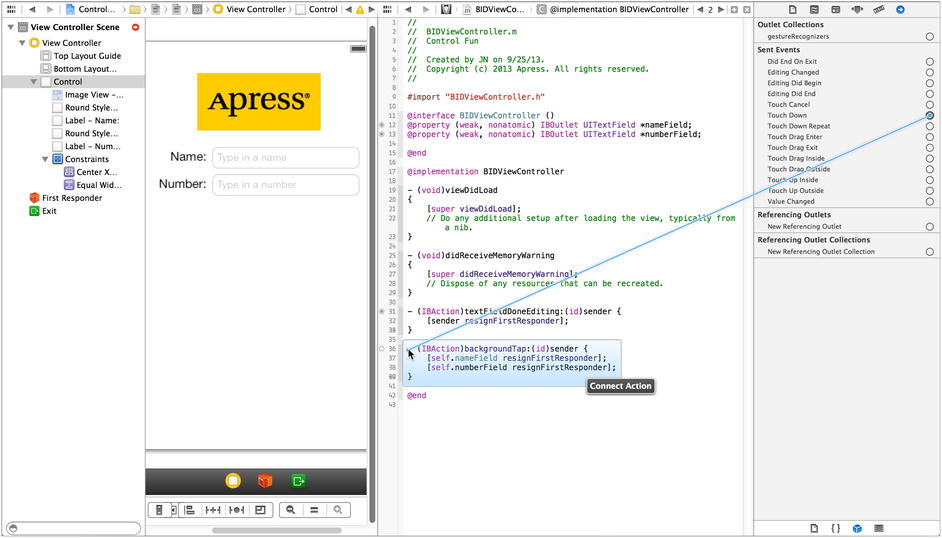
Figure 4-19. By changing the class of our view from UIView to UIControl, we gain the ability to trigger action methods on any of the standard events. We’ll connect the view’s Touch Down event to the backgroundTap: action
Note You might be wondering why we selected Touch Down instead of Touch Up Inside, as we did in the previous chapter. The answer is that the background isn’t a button. It’s not a control in the eyes of the user, so it wouldn’t occur to most users to try to drag their finger somewhere to cancel the action.
Save the storyboard, and then compile and run your application again. This time, the keyboard should disappear not only when the Done button is tapped, but also when you tap anywhere that’s not an active control, which is the behavior that your users will expect.
Excellent! Now that we have this section all squared away, are you ready to move on to the next group of controls?
Adding the Slider and Label
Now it’s time to add the slider and accompanying label. Remember that the value in the label will change as the slider is used. Select Main.storyboard in the project navigator, so we can add more items to our application’s user interface.
Before we place the slider, let’s add a bit of breathing room to our design. The blue guidelines we used to determine the spacing between the top text field and the image above it are really suggestions for minimum proximity. In other words, the blue guidelines tell you, “Don’t get any closer than this.” Drag the two text fields and their labels down a bit, using Figure 4-1 as a guide. Now let’s add the slider.
From the object library, bring over a slider and arrange it below the Number text field, using the right-hand side’s blue guideline as a stopping point and leaving a little breathing room below the bottom text field. Our slider ended up about halfway down the view. Single-click the newly added slider to select it, and then press ![]()
![]() 4 to go back to the object attributes inspector if it’s not already visible (see Figure 4-20).
4 to go back to the object attributes inspector if it’s not already visible (see Figure 4-20).
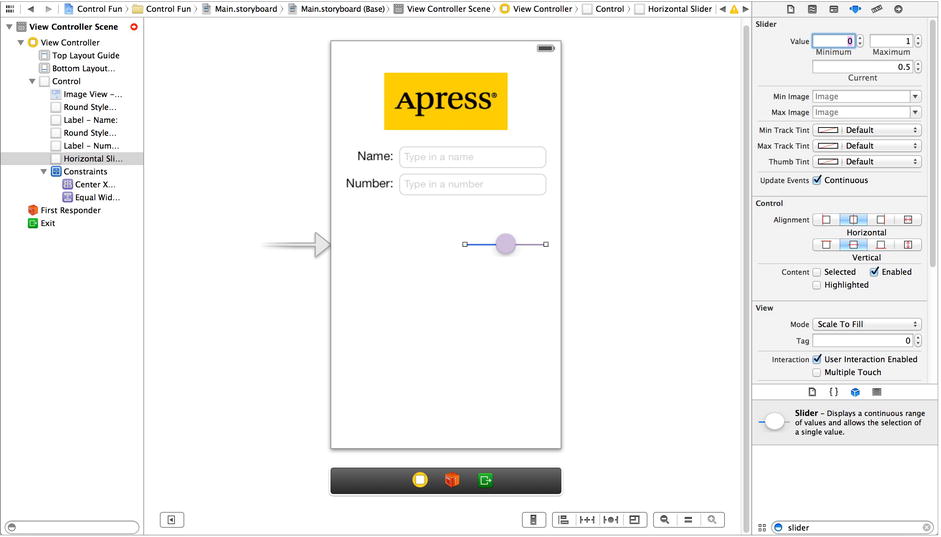
Figure 4-20. The inspector showing default attributes for a slider
A slider lets you choose a number in a given range. Use the inspector to set the Minimum value to 1, the Maximum value to 100, and the Current value to 50. Leave the Update Events, Continuous checkbox checked. This ensures a continuous flow of events as the slider’s value changes. That’s all we need to worry about for now.
Bring over a label and place it next to the slider, using the blue guidelines to align it vertically with the slider and to align its left edge with the left margin of the view (see Figure 4-21).
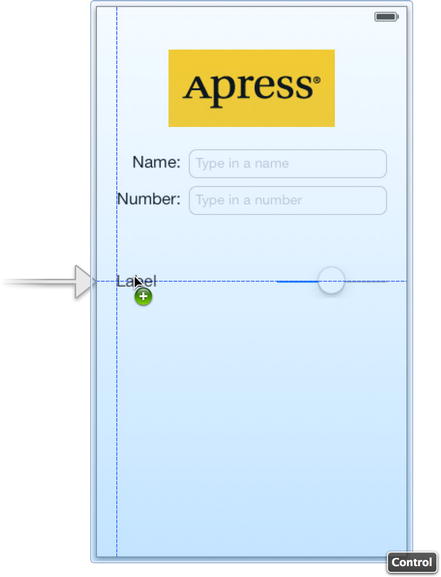
Figure 4-21. Placing the slider’s label
Double-click the newly placed label, and change its text from Label to 100. This is the largest value that the slider can hold, and we can use that to determine the correct width of the slider. Since “100” is shorter than “Label,” Interface Builder automatically makes the label smaller for you, as if you had dragged the right-middle resize dot to the edge. Despite this automatic behavior, you’re still free to resize the label however you want, of course. If you later decide you want the tool to pick the optimum size for you again, just press ![]() = or select Editor
= or select Editor ![]() Size to Fit Content.
Size to Fit Content.
Next, resize the slider by single-clicking the slider to select it and dragging the left resize dot to the left until the blue guidelines indicate that you’re getting close to the label’s right-side edge.
Adding Constraints
Before we go on, we need to adjust some constraints for this layout. When you drag a view into another view in Interface Builder (as we just did), Xcode doesn’t create any constraints for it automatically. The layout system requires a complete set of constraints, so when it’s time to compile your app, Xcode will make a set of default constraints describing the layout. Which sort of constraints are created depends on each object’s position within its superview. Depending on whether it’s nearer the left or right edge, it will be pinned to the left of the right. Similarly, depending on whether it’s nearer the top or the bottom edge, it will be pinned to the top or the bottom. If it’s centered in either direction, it will typically get a constraint pinning it to the center.
To complicate matters further, Xcode may also apply automatic constraints pinning each new object to one or more of its “sibling” objects within the same superview. This automatic behavior may or may not be what you want, so normally you’re better off creating a complete set of constraints within Interface Builder before your app is compiled.
Let’s start poking around what we have so far. To see all the constraints that are in play for any particular view, try selecting it and opening the size inspector. If you select any of the labels, text fields, or the slider, you’ll see that the size inspector shows a message claiming that there are no constraints for the selected view. In fact, this GUI we’ve been building has only one constraint: binding the horizontal centers of the image view and the container view. Click either the container view or the image view to see this constraint in the inspector.
What we really want is a full set of constraints to tell the layout system precisely how to handle all our views and controls, just as it would get at compile time. Fortunately, this is pretty simple to accomplish. Select all the views and controls by click-dragging a box around them, from inside the upper-left corner of our container view down toward the lower right. When all items are selected, use the menu to execute the Editor ![]() Resolve Auto Layout Issues
Resolve Auto Layout Issues ![]() Add Missing Constraints command. After doing that, you’ll see that all our views and controls now have some little blue sticks connecting them to one another and to the container view. Each of those sticks represents a constraint. The big advantage to creating these now instead of letting Xcode create them at compile time is that we now have a chance to modify each constraint if we need to. We’ll explore more of what we can do with constraints throughout the book.
Add Missing Constraints command. After doing that, you’ll see that all our views and controls now have some little blue sticks connecting them to one another and to the container view. Each of those sticks represents a constraint. The big advantage to creating these now instead of letting Xcode create them at compile time is that we now have a chance to modify each constraint if we need to. We’ll explore more of what we can do with constraints throughout the book.
Normally, the layout we’ve created here wouldn’t require any particular modification of these constraints to make sure it works fine on all devices. However, it’s important to know that things changed a bit with the release of the iPhone 5. iPhones and iPod touches now come in two distinct screen sizes. This means that when the system is loading a set of GUI components from a storyboard or nib file, it may have to adjust the content to a different screen size than what the nib file contains, and then reapply all the constraints in the process. User interfaces created in Xcode now start off at the iPhone 5 size, also called “iPhone Retina 4” (since it’s a 4-inch screen) by default. So, if some of your views are bound to the top of the superview, and some are bound to the bottom or the center, you’re likely to be in for a surprise when running on an iPhone 4 (its screen size is now referred to as “iPhone Retina 3.5”) because some of the controls are vertically squashed together.
For our current GUI, this isn’t a problem, however, which we can verify by doing the following. At the bottom-right corner of the editing area, you’ll see a row of buttons for performing some common actions when editing your user interface. The leftmost of these buttons shows an Apply Retina 3.5-inch Form Factor tooltip when you let your mouse pointer hover there. Click there, and you’ll see that the size of the container view changes, but all the views and controls remain positioned as expected. Click again to switch back to the Retina 4-inch form factor, and you’ll see that everything remains OK. Later in the book, we’ll deal with some GUIs that need a bit of adjustment in this area.
Creating and Connecting the Actions and Outlets
All that’s left to do with these two controls is to connect the outlet and action. We will need an outlet that points to the label, so that we can update the label’s value when the slider is used. We’re also going to need an action method for the slider to call as it’s changed.
Make sure you’re using the assistant editor and editing BIDViewController.m, and then control-drag from the slider to just above the @end declaration in the assistant editor. When the pop-up window appears, change the Connection pop-up menu to Action, and then type sliderChanged in the name field. Set the Type to UISlider, then hit Return to create and connect the action.
Next, control-drag from the newly added label (the one showing “100”) over to the assistant editor. This time, drag to just below the last property declaration, in between the @interface and @end at the top. When the pop-up comes up, type sliderLabel into the Name text field, and then hit Return to create and connect the outlet.
Implementing the Action Method
Though Xcode has created and connected our action method, it’s still up to us to actually write the code that makes up the action method so it does what it’s supposed to do. Save your work, and then, in the project navigator, single-click BIDViewController.m and look for the sliderChanged: method, which should be empty. Add this code to that method:
- (IBAction)sliderChanged:(UISlider *)sender {
int progress = lroundf(sender.value);
self.sliderLabel.text = [NSString stringWithFormat:@"%d", progress];
}
The first line in the method retrieves the current value of the slider, rounds it to the nearest integer, and assigns it to an integer variable. The second line of code creates a string containing that number and assigns it to the label.
That takes care of our controller’s response to the movements of the slider; but in order to be really consistent, we need to make sure that the label shows the correct slider value before the user even touches it. Add this line to the viewDidLoad method:
- (void)viewDidLoad
{
[super viewDidLoad];
// Do any additional setup after loading the view, typically from a nib.
self.sliderLabel.text = @"50";
}
The preceding method will be executed immediately after the running app loads the view from the storyboard file, but before it’s displayed on the screen. The line we added makes sure that the user sees the correct starting value right away.
Save the file. Next, press ![]() R to build and launch your app in the iOS simulator, and try out the slider. As you move it, you should see the label’s text change in real time. Another piece falls into place.
R to build and launch your app in the iOS simulator, and try out the slider. As you move it, you should see the label’s text change in real time. Another piece falls into place.
But if you drag the slider toward the left (bringing the value below 10) or all the way to the right (setting the value to 100), you’ll see an odd thing happen. The label to the left will shrink horizontally when it drops down to showing a single digit, and will grow horizontally when showing three. Now, apart from the text it contains, you don’t actually see the label itself, so you can’t see its size changing, but what you will see is that the slider actually changes its size along with the label, getting smaller or larger. It’s maintaining a size relationship with the label, making sure the gap between the two is always the same.
This isn’t anything we’ve asked for, is it? Not really. It’s simply a side effect of the way Interface Builder works, helping you create GUIs that are responsive and fluid. We created some default constraints previously, and here you’re seeing one in action. One of the constraints created by Interface Builder keeps the horizontal distance between these elements constant.
Fortunately, you can override this behavior by making your own constraint. Back in Xcode, select the slider in your nib, and select Editor ![]() Pin
Pin ![]() Width from the menu. This makes a new high-priority constraint that tells the layout system, “Don’t mess with the width of this slider.” If you now press
Width from the menu. This makes a new high-priority constraint that tells the layout system, “Don’t mess with the width of this slider.” If you now press ![]() R to build and run again, you’ll see that the slider no longer expands and contracts as you drag back and forth across it.
R to build and run again, you’ll see that the slider no longer expands and contracts as you drag back and forth across it.
We’ll see more examples of constraints and their uses throughout the book. But for now, let’s look at implementing the switches.
Implementing the Switches, Button, and Segmented Control
Back to Xcode we go once again. Getting dizzy, yet? This back and forth may seem a bit strange, but it’s fairly common to bounce around between source code, storyboards, and nib files in Xcode, testing your app in the iOS simulator while you’re developing.
Our application will have two switches, which are small controls that can have only two states: on and off. We’ll also add a segmented control to hide and show the switches. Along with that control, we’ll add a button that is revealed when the segmented control’s right side is tapped. Let’s implement those next.
Back in the storyboard, drag a segmented control from the object library (see Figure 4-22) and place it on the View window, a little below the slider.

Figure 4-22. Here’s what we see when dragging a segmented control from the library to the left side of the parent view. Next, we’ll resize the segmented control, so it stretches to the right side of the view
Tip To give you a sense of the spacing we’re going for, take a look at the image view with the Apress logo. We tried to leave about the same amount of space above and below the image view. We did the same thing with the slider: we tried to leave about the same amount of space above and below the slider.
Expand the width of the segmented control, so that it stretches from the view’s left margin to its right margin. Double-click the word First on the segmented control and change the title from First to Switches. After doing that, repeat the process with the Second segment, renaming it Button (see Figure 4-23).
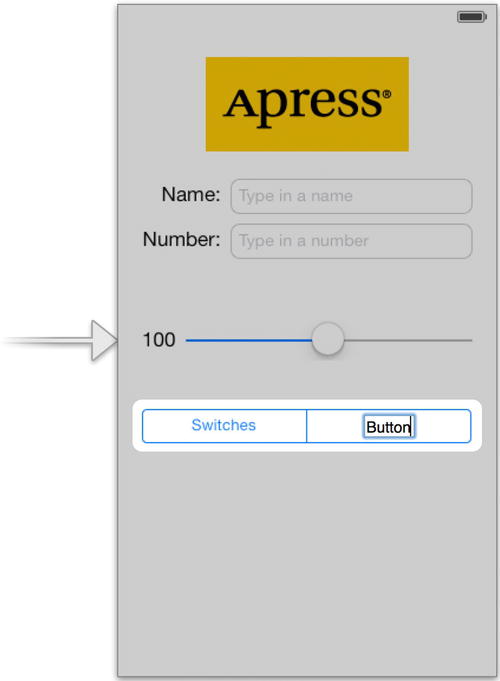
Figure 4-23. Renaming the segments in the segmented control
Adding Two Labeled Switches
Next, grab a switch from the library and place it on the view, below the segmented control and against the left margin. Now drag a second switch and place it against the right margin, aligned vertically with the first switch (see Figure 4-24).
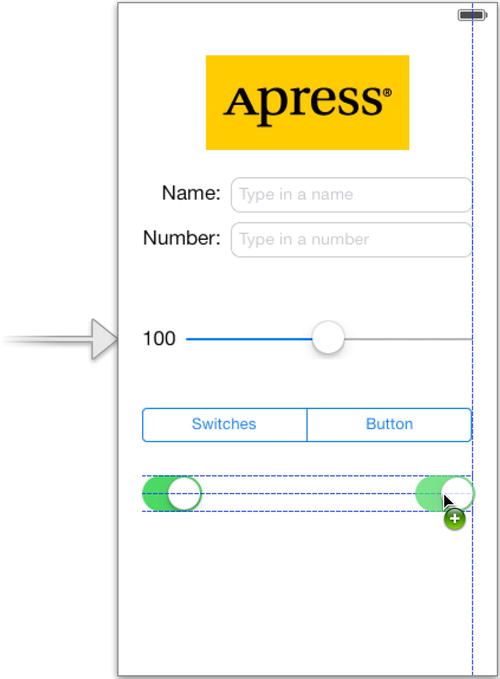
Figure 4-24. Adding the switches to the view
Tip Holding down the ![]() key and dragging an object in Interface Builder will create a copy of that item. When you have many instances of the same object to create, it can be faster to drag only one object from the library, and then option-drag as many copies as you need.
key and dragging an object in Interface Builder will create a copy of that item. When you have many instances of the same object to create, it can be faster to drag only one object from the library, and then option-drag as many copies as you need.
Connecting and Creating Outlets and Actions
Before we add the button, we’ll create outlets for the two switches and connect them. The button that we’ll be adding next will actually sit on top of the switches, making it harder to control-drag to and from them, so we want to take care of the switch connections before we add the button. Since the button and the switches will never be visible at the same time, having them in the same physical location won’t be a problem.
Using the assistant editor, control-drag from the switch on the left to just below the last outlet in BIDViewController.m. When the pop-up appears, name the outlet leftSwitch and hit Return. Repeat this process with the other switch, naming its outlet rightSwitch.
Now, select the left switch again by single-clicking it. Control-drag once more to the assistant editor. This time, drag to right above the @end declaration before letting go. When the pop-up appears, name the new action method switchChanged:, and set the Type of its sender argument to UISwitch. Next, hit Return to create the new action. Now repeat this process with the right switch, with one change: instead of creating a new action, drag to the switchChanged: action that was just created and connect to it, instead. Just as we did in the previous chapter, we’re going to use a single method to handle both switches.
Finally, control-drag from the segmented control to the assistant editor, right above the @end declaration. Insert a new action method called toggleControls:, just as you’ve done before. This time, set the Type of its sender parameter to UISegmentedControl.
Implementing the Switch Actions
Save the storyboard and divert your attention to BIDViewController.m, which is already open in the assistant view. Look for the switchChanged: method that was added for you automatically and add this code to it:
- (IBAction)switchChanged:(UISwitch *)sender {
BOOL setting = sender.isOn;
[self.leftSwitch setOn:setting animated:YES];
[self.rightSwitch setOn:setting animated:YES];
}
The switchChanged: method is called whenever one of the two switches is tapped. In this method, we simply grab the isOn value of sender (which represents the switch that was pressed) and use that value to set both switches. The idea here is that setting the value of one switch will change the other switch at the other time, keeping them in sync at all times.
Now, sender is always going to be either leftSwitch or rightSwitch, so you might be wondering why we’re setting them both. The reason is one of practicality. It’s less work to set the value of both switches every time than to determine which switch made the call and set only the other one. Whichever switch called this method will already be set to the correct value, and setting it again to that same value won’t have any effect.
Adding the Button
Next, go back to Interface Builder and drag a Button from the library to your view. Add this button directly on top of the leftmost switch, aligning it with the left margin and vertically aligning its top edge with the top edge of the two switches (see Figure 4-25).

Figure 4-25. Adding a button on top of the existing switches
Now, grab the right-center resize handle and drag all the way to the right until you reach the blue guideline that indicates the right-side margin. The button should completely overlay the space occupied by the two switches, but because the default button is transparent, you will still see the switches (see Figure 4-26).

Figure 4-26. The round rect button, once placed and resized, will fill the space occupied by the two switches
Double-click the newly added button and give it a title of Do Something.
Spiffing Up the Button
If you compare your running application to Figure 4-2, you might notice an interesting difference. Your Do Something button doesn’t look like the one in the figure. That’s because the default button in iOS 7 has a very simple appearance: it’s just a piece of plain text with no outline, border, background color, or other decorative features. That conforms nicely to Apple’s new design guidelines for iOS 7, but there are still cases where you’ll want to use custom buttons, so we’re going to show you how it’s done.
Many of the buttons you see on your iOS device are drawn using images. Don’t worry; you don’t need to create images in an image editor for every button. All you need to do is specify a kind of template image that iOS will use when drawing your buttons.
It’s important to keep in mind that your application is sandboxed. You can’t get to the template images that are used in other applications on your iOS device or the ones used by iOS itself, so you must make sure that any images you need are in your application’s bundle. So, where can you get these image templates?
Fortunately, Apple has provided a bunch for you. You can get them from the iPhone sample application called UICatalog, available from the iOS Developer Library:
http://developer.apple.com/library/ios/#samplecode/UICatalog/index.html
Alternatively, you can simply copy the images from the 04 - Control Fun folder from this book’s project archive. Yes, it is OK to use these images in your own applications because Apple’s sample code license specifically allows you to use and distribute them.
So, from either the 04 - Control Fun folder or the images subfolder of the UICatalog project’s folder, find the two images named blueButton.png and whiteButton.png. In Xcode, select Images.xcassets (the same assets catalog that we used earlier when we added images for the Apress logo), then just drag both images from the Finder straight into the editing area in your Xcode window. The images are added to your project and will be immediately available through your app.
Stretchable Images
Now, if you look at the two button images we just added, you’ll probably be struck by the size of them. They’re very small, and seem much too narrow to fill out the button you added to the storyboard. That’s because these graphics are meant to be stretchable. It so happens that UIKit can stretch graphics to nicely fill just about any size you want. Stretchable images are an interesting concept. A stretchable image is a resizable image that knows how to resize itself intelligently, so that it maintains the correct appearance. For these button templates, we don’t want the edges to stretch evenly with the rest of the image. Edge insets are the parts of an image, measured in pixels, that should not be resized. We want the bevel around the edges to stay the same, no matter what size we make the button, so we need to specify how much non-stretchable space makes up each edge.
In the past, this could only be accomplished in code. You’d have to use a graphics program to measure pixel boundaries of your images, then use those number to set edge insets in your code. Xcode 5 eliminates the need for this however, by letting you visually “slice” any image you have in an assets catalog! That’s what we’re going to do next.
Select the Images.xcassets asset catalog in Xcode, and inside that select whiteButton. At the bottom of the editing area, you’ll see a button labeled Show Slicing. Click that to initiate the slicing process, which begins by simply putting a Start Slicing button right on top of your image. That’s where the magic begins, so click it! You’ll see three new buttons that let you choose whether you want the image to be sliced (and therefore stretchable) vertically, horizontally, or both. Choose the button in the middle to slice both ways. Xcode does a quick analysis of your image, and then finds the sections that seem to have unique pixels around the edges, and vertical and horizontal slices in the middle that should be repeatable. You’ll see these boundaries represented by dashed lines, as shown in Figure 4-27. If you have a tricky image, you may need to adjust these (it’s easy to do, just drag them with the mouse); but for this image, the automatic edge insets will work fine.

Figure 4-27. This is what the default slicing for the white button looks like
Next, select blueButton and do the same automatic slicing for it. All done! Now it’s time to put these graphics to use.
Go back to the storyboard you’ve been working on and single-click the Do Something button. Yeah, we know, the button is now invisible because we marked it as hidden; however, you should have no problem seeing the ghost image. In addition, you can also click the button in the hierarchical view at the left side, if you have it open.
With the button selected, press ![]()
![]() 4 to open the attributes inspector. In the inspector, first go down to the View section and turn off the Hidden checkbox, just so we can see what we’re doing. Next, go back up to the top and use the first pop-up menu to change the type from System to Custom. You’ll see in the inspector that you can specify an Image and a Background for your button. We’re going to use the Background to show our resizable graphic, so click in the Background pop-up and select whiteButton. You’ll see that the button now shows the white graphic, perfectly stretched to cover the entire button frame. Nice!
4 to open the attributes inspector. In the inspector, first go down to the View section and turn off the Hidden checkbox, just so we can see what we’re doing. Next, go back up to the top and use the first pop-up menu to change the type from System to Custom. You’ll see in the inspector that you can specify an Image and a Background for your button. We’re going to use the Background to show our resizable graphic, so click in the Background pop-up and select whiteButton. You’ll see that the button now shows the white graphic, perfectly stretched to cover the entire button frame. Nice!
Now we want to use the blue button to define the look of this button’s highlighted state, which is what you see while the button is pressed. We’ll talk more about control states in the next section of this chapter; but for now, just take a look at the second pop-up from the top, labeled State Config. A UIButton can have multiple states, each with its own text and images. Right now we’ve been configuring the default state, so switch this pop-up to Highlighted, so that we can configure that state. You’ll see that the Background popup has been cleared; click it to select blueButton, and you’re done!
There’s just one problem with this new button appearance: The default UIButton size isn’t tall enough to properly show the gradient buttons we imported. Use the resizing control at the bottom edge of the button, dragging it down to make the button a little taller. It will actually snap into position when it reaches the appropriate height, just a few pixels larger than it started out.
Configuring this button introduces two new concepts: stretchable images and control states. We already talked about the former, so now let’s tackle the latter.
Control States
Every iOS control has four possible control states and is always in one, and only one, of these states at any given moment:
- Normal: The most common state is the normal control state, which is the default state. It’s the state that controls are in when not in any of the other states.
- Highlighted: The highlighted state is the state a control is in when it’s currently being used. For a button, this would be while the user has a finger on the button.
- Disabled: Controls are in the disabled state when they have been turned off, which can be done by unchecking the Enabled checkbox in Interface Builder or setting the control’s enabled property to NO.
- Selected: Only some controls support the selected state. It is usually used to indicate that the control is turned on or selected. Selected is similar to highlighted, but a control can continue to be selected when the user is no longer directly using that control.
Certain iOS controls have attributes that can take on different values depending on their state. For example, by specifying one image for UIControlStateNormal and a different image for UIControlStateHighlighted, we are telling iOS to use one image when the user has a finger on the button and a different image the rest of the time. That’s essentially what we did when we configured two different background states for the button in the storyboard.
Connecting and Creating the Button Outlets and Actions
Control-drag from the new button to the assistant editor, just below the last outlet already in the section at the top of the file. When the pop-up appears, create a new outlet called doSomethingButton. After you’ve done that, control-drag from the button a second time to just above the @end declaration at the bottom of the file. There, create an action called buttonPressed:. We don’t need to set the Type to anything in particular because the method we’ll write soon won’t use it, anyway.
If you save your work and take the application for a test drive, you’ll see that the segmented control will be live, but it won’t do anything particularly useful yet. We need to add some logic to make the button and switches hide and unhide.
We also need to mark our button as hidden from the start. We didn’t want to do that before because it would have made it harder to connect the outlets and actions. Now that we’ve done that, however, let’s hide the button. We’ll show the button when the user taps the right side of the segmented control; but when the application starts, we want the button hidden. Press ![]()
![]() 4 to bring up the attributes inspector, scroll down to the View section, and click the Hidden checkbox. The button will still be visible in Interface Builder, but will look faded out and transparent, to indicate its hidden status.
4 to bring up the attributes inspector, scroll down to the View section, and click the Hidden checkbox. The button will still be visible in Interface Builder, but will look faded out and transparent, to indicate its hidden status.
Implementing the Segmented Control Action
Save the storyboard and focus once again on BIDViewController.m. Look for the toggleControls: method that Xcode created for us and add the code in bold to it:
- (IBAction)toggleControls:(UISegmentedControl *)sender {
// 0 == switches index
if (sender.selectedSegmentIndex == 0) {
self.leftSwitch.hidden = NO;
self.rightSwitch.hidden = NO;
self.doSomethingButton.hidden = YES;
}
else {
self.leftSwitch.hidden = YES;
self.rightSwitch.hidden = YES;
self.doSomethingButton.hidden = NO;
}
}
This code looks at the selectedSegmentIndex property of sender, which tells us which of the sections is currently selected. The first section, called switches, has an index of 0. We’ve noted this fact in a comment, so that when we revisit the code later, we will know what’s going on. Depending on which segment is selected, we hide or show the appropriate controls.
At this point, save and try running the application in the iOS simulator. If you’ve typed everything correctly, you should be able to switch between the button and the pair of switches using the segmented control. And if you tap either switch, the other one will change its value as well. The button, however, still doesn’t do anything. Before we implement it, we need to talk about action sheets and alerts.
Implementing the Action Sheet and Alert
Action sheets and alerts are both used to provide the user with feedback:
- Action sheets are used to force the user to make a choice between two or more items. The action sheet comes up from the bottom of the screen and displays a series of buttons (see Figure 4-3). Users are unable to continue using the application until they have tapped one of the buttons. Action sheets are often used to confirm a potentially dangerous or irreversible action such as deleting an object.
- Alerts appear as a rounded rectangle in the middle of the screen (see Figure 4-4). Like action sheets, alerts force users to respond before they are allowed to continue using the application. Alerts are usually used to inform the user that something important or out of the ordinary has occurred. Unlike action sheets, alerts may be presented with only a single button, although you have the option of presenting multiple buttons if more than one response is appropriate.
Note A view that forces users to make a choice before they are allowed to continue using their application is known as a modal view.
Conforming to the Action Sheet Delegate Method
Remember back in Chapter 3 when we talked about the application delegate? Well, UIApplication is not the only class in Cocoa Touch that uses delegates. In fact, delegation is a common design pattern in Cocoa Touch. Action sheets and alerts both use delegates, so that they know which object to notify when they’re dismissed. In our application, we’ll need to be notified when the action sheet is dismissed. We don’t need to know when the alert is dismissed because we’re just using it to notify the user of something, not to solicit a choice.
In order for our controller class to act as the delegate for an action sheet, it needs to conform to a protocol called UIActionSheetDelegate. We do that by adding the name of the protocol in angle brackets after the superclass in our class declaration. Add this protocol declaration to BIDViewController.h:
#import <UIKit/UIKit.h>
@interface BIDViewController : UIViewController<UIActionSheetDelegate>
. . .
Showing the Action Sheet
Let’s switch over to BIDViewController.m and implement the button’s action method. We actually need to implement another method in addition to our existing action method: the UIActionSheetDelegate method that the action sheet will use to notify us that it has been dismissed.
Begin by looking for the empty buttonPressed: method that Xcode created for you, and then add the code in bold to that method to create and show the action sheet:
- (IBAction)buttonPressed:(id)sender {
UIActionSheet *actionSheet = [[UIActionSheet alloc]
initWithTitle:@"Are you sure?"
delegate:self
cancelButtonTitle:@"No Way!"
destructiveButtonTitle:@"Yes, I’m Sure!"
otherButtonTitles:nil];
[actionSheet showInView:self.view];
}
Next, add a new method just after the existing buttonPressed: method:
- (void)actionSheet:(UIActionSheet *)actionSheet
didDismissWithButtonIndex:(NSInteger)buttonIndex
{
if (buttonIndex != [actionSheet cancelButtonIndex]) {
NSString *msg = nil;
if ([self.nameField.text length] > 0) {
msg = [NSString stringWithFormat:
@"You can breathe easy, %@, everything went OK.",
self.nameField.text];
} else {
msg = @"You can breathe easy, everything went OK.";
}
UIAlertView *alert = [[UIAlertView alloc]
initWithTitle:@"Something was done"
message:msg
delegate:self
cancelButtonTitle:@"Phew!"
otherButtonTitles:nil];
[alert show];
}
}
What exactly did we do there? Well, first, in the doSomething: action method, we allocated and initialized a UIActionSheet object, which is the object that represents an action sheet (in case you couldn’t puzzle that one out for yourself):
UIActionSheet *actionSheet = [[UIActionSheet alloc]
initWithTitle:@"Are you sure?"
delegate:self
cancelButtonTitle:@"No Way!"
destructiveButtonTitle:@"Yes, I’m Sure!"
otherButtonTitles:nil];
The initializer method takes a number of parameters. Let’s look at each of them in turn.
The first parameter is the title to be displayed. Refer back to Figure 4-3 to see how the title we’re supplying will be displayed at the top of the action sheet.
The second parameter is the delegate for the action sheet. The action sheet’s delegate will be notified when a button on that sheet has been tapped. More specifically, the delegate’s actionSheet:didDismissWithButtonIndex: method will be called. By passing self as the delegate parameter, we ensure that our version of actionSheet:didDismissWithButtonIndex: will be called.
Next, we pass in the title for the button that users will tap to indicate they do not want to proceed. All action sheets should have a cancel button, though you can give it any title that is appropriate to your situation. You do not want to use an action sheet if there is no choice to be made. In situations where you want to notify the user without giving a choice of options, an alert view is more appropriate.
The next parameter is the destructive button, and you can think of this as the “yes, please go ahead” button; again, though, you can assign it any title.
The last parameter allows you to specify any number of other buttons that you may want shown on the sheet. This final argument can take a variable number of values, which is one of the nice features of the Objective-C language. If we had wanted two more buttons on our action sheet, we could have done it like this:
UIActionSheet *actionSheet = [[UIActionSheet alloc]
initWithTitle:@"Are you sure?"
delegate:self
cancelButtonTitle:@"No Way!"
destructiveButtonTitle:@"Yes, I’m Sure!"
otherButtonTitles:@"Foo", @"Bar", nil];
This code would have resulted in an action sheet with four buttons. You can pass as many arguments as you want in the otherButtonTitles parameter, as long as you pass nil as the last one. Of course, there is a practical limitation on how many buttons you can have, based on the amount of screen space available.
After we create the action sheet, we tell it to show itself:
[actionSheet showInView:self.view];
Action sheets always have a parent, which must be a view that is currently visible to the user. In our case, we want the view that we designed in Interface Builder to be the parent, so we use self.view. Note the use of Objective-C dot notation. self.view is equivalent to saying [self view], using the accessor to return the value of our view property.
Why didn’t we just use view, instead of self.view? Our parent class UIViewController may have an instance variable called view, but it doesn’t expose it, not even to a subclass like ours. This means we can’t access it directly, but instead must use an accessor method.
Well, that wasn’t so hard, was it? In just a few lines of code, we showed an action sheet and required the user to make a decision. iOS will even animate the sheet for us without requiring us to do any additional work. Now, we just need to find out which button the user tapped. The other method that we just implemented, actionSheet:didDismissWithButtonIndex, is one of the UIActionSheetDelegate methods; and since we specified self as our action sheet’s delegate, this method will automatically be called by the action sheet when a button is tapped.
The argument buttonIndex will tell us which button was actually tapped. But how do we know which button index refers to the cancel button and which one refers to the destructive button? Fortunately, the delegate method receives a pointer to the UIActionSheet object that represents the sheet, and that action sheet object knows which button is the cancel button. We just need look at one of its properties, cancelButtonIndex:
if (buttonIndex != [actionSheet cancelButtonIndex])
This line of code makes sure the user didn’t tap the cancel button. Since we gave the user only two options, we know that if the cancel button wasn’t tapped, the destructive button must have been tapped, and it’s OK to proceed. Once we know the user didn’t cancel, the first thing we do is create a new string that will be displayed to the user. In a real application, this is where you would do whatever processing the user requested. We’re just going to pretend we did something, and notify the user by using an alert.
If the user has entered a name in the top text field, we’ll grab that, and we’ll use it in the message that we’ll display in the alert. Otherwise, we’ll just craft a generic message to show:
NSString *msg = nil;
if ([self.nameField.text length] > 0) {
msg = [NSString stringWithFormat:
@"You can breathe easy, %@, everything went OK.",
self.nameField.text];
}
else {
msg = @"You can breathe easy, everything went OK.";
}
The next few lines of code are going to look kind of familiar. Alert views and action sheets are created and used in a very similar manner:
UIAlertView *alert = [[UIAlertView alloc]
initWithTitle:@"Something was done"
message:msg
delegate:nil
cancelButtonTitle:@"Phew!"
otherButtonTitles:nil];
Again, we pass a title to be displayed. We also pass a more detailed message, which is that string we just created. Alert views have delegates, too; and if we needed to know when the user had dismissed the alert view or which button was tapped, we could specify self as the delegate here, just as we did with the action sheet. If we had done that, we would now need to conform our class to the UIAlertViewDelegate protocol, and implement one or more of the methods from that protocol. In this case, we’re just informing the user of something and giving the user only one button. We don’t really care when the button is tapped, and we already know which button will be tapped, so we just specify nil here to indicate that we don’t need to be pinged when the user is finished with the alert view.
Alert views, unlike action sheets, are not tied to a particular view, so we just tell the alert view to show itself without specifying a parent view. After that, we’re finished. Save the file, then build, run, and try out the completed application.
One Last Tweak
With iOS 7, Apple has introduced some new GUI paradigms. One of these is that the status bar at the top of the screen is transparent in iOS 7 apps, so that your content shines right through it. Right now, that yellow Apress icon really sticks out like a sore thumb against our app’s white background, so let’s extend that yellow color to cover our entire view. In Main.storyboard, select the main content view, and press ![]()
![]() 4 to bring up the attributes inspector. Click the color swatch labeled Background to open the standard OS X color picker. One feature of this color picker is that it lets you choose any color you see on the screen. Just click the icon showing magnifying glass at the upper left, then click anywhere in the yellow part of the Apress icon to set that color as the background for the entire view. When you’re done, close the color picker.
4 to bring up the attributes inspector. Click the color swatch labeled Background to open the standard OS X color picker. One feature of this color picker is that it lets you choose any color you see on the screen. Just click the icon showing magnifying glass at the upper left, then click anywhere in the yellow part of the Apress icon to set that color as the background for the entire view. When you’re done, close the color picker.
On your screen, you may find that the background and the Apress image seem to have slightly different colors, but when run in the simulator or on a device they will be the same. These colors appear to be different in Interface Builder because OS X automatically adapts colors depending on the display you’re using. On an iOS device, and in the simulator, that doesn’t happen.
Now run your app, and you’ll see that the yellow color fills the entire screen, with no visible distinction between the status bar and your app’s content. If you don’ t have full-screen scrolling content, or other content that requires the use of a navigation bar or other controls at the top of the screen, this can be a nice way to show full-screen content that isn’t interrupted by the status bar quite as much.
Crossing the Finish Line
This was a big chapter. Conceptually, we didn’t hit you with too much new stuff, but we took you through the use of a good number of controls and showed you many different implementation details. You got a lot more practice with outlets and actions, saw how to use the hierarchical nature of views to your advantage, and cut your teeth on some constraints. You learned about control states and stretchable images, and you also learned how to use both action sheets and alerts.
There’s a lot going on in this little application. Feel free to go back and play with it. Change values, experiment by adding and modifying code, and see what different settings in Interface Builder do. There’s no way we could take you through every permutation of every control available in iOS, but the application you just put together is a good starting point and covers a lot of the basics.
In the next chapter, we’re going to look at what happens when the user rotates an iOS device from portrait to landscape orientation or vice versa. You’re probably well aware that many apps change their displays based on the way the user is holding the device, and we’re going to show you how to do that in your own applications.
